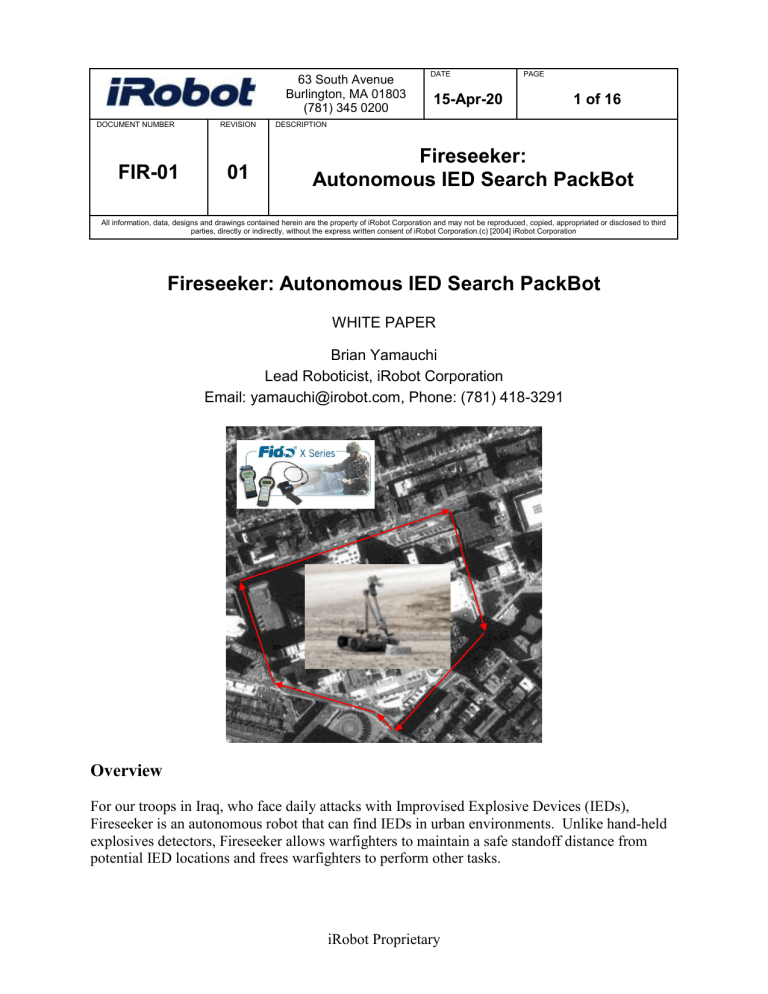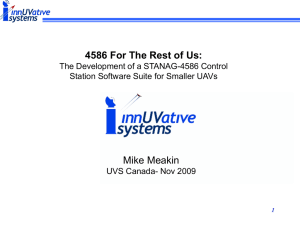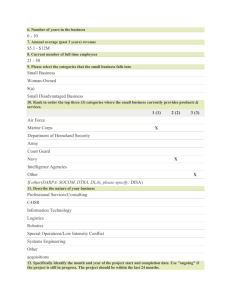Fireseeker UGV - Brian Yamauchi

REVISION
63 South Avenue
Burlington, MA 01803
(781) 345 0200
DESCRIPTION
DATE
15-Apr-20
PAGE
1 of 16
DOCUMENT NUMBER
FIR-01 01
Fireseeker:
Autonomous IED Search PackBot
All information, data, designs and drawings contained herein are the property of iRobot Corporation and may not be reproduced, copied, appropriated or disclosed to third parties, directly or indirectly, without the express written consent of iRobot Corporation.(c) [2004] iRobot Corporation
Fireseeker: Autonomous IED Search PackBot
WHITE PAPER
Brian Yamauchi
Lead Roboticist, iRobot Corporation
Email: yamauchi@irobot.com, Phone: (781) 418-3291
Overview
For our troops in Iraq, who face daily attacks with Improvised Explosive Devices (IEDs),
Fireseeker is an autonomous robot that can find IEDs in urban environments. Unlike hand-held explosives detectors, Fireseeker allows warfighters to maintain a safe standoff distance from potential IED locations and frees warfighters to perform other tasks. iRobot Proprietary
DOCUMENT NO.
FIR-01
REVISION
01
DESCRIPTION
Fireseeker: Autonomous IED Search
PackBot
PAGE
2 of 16
US soldiers in Iraq are currently testing PackBots equipped with Nomadics Fido explosives sensors to determine their ability to detect IEDs placed by insurgents. While teleoperated robots provide some additional standoff distance for warfighters, Fireseeker takes this capability to the next level, allowing soldiers to specify a particular area to be searched for explosives and enabling the robot to perform the search autonomously.
Each Fireseeker UGV provides the following benefits:
Can autonomously search for IEDs and VBIEDs in urban terrain
Frees warfighters for other tasks
Reduces manpower requirements
Increases standoff distance from suspected IEDs and VBIEDs
Man-portable for quick, easy deployment
Battle-tested PackBot platform (over 200 deployed in Iraq and Afghanistan)
Field-tested Fido explosives sensor
Established logistics and maintenance support capabilities
Each Fireseeker UGV is capable of performing a wide range of IED search missions including:
Perimeter Search
Search a building perimeter for IEDs and/or VBIEDs and mark their locations on a map
5-and-25 Clearance
Deploy from a stopped vehicle carrying mounted troops and search a 5-meter radius around the vehicle for IEDs and then a 25-meter radius
In each case the Fireseeker UGV operates completely autonomously and relays its findings back to its Operator Control Unit (OCU) in real-time.
Concept of Operations (CONOPS) Scenarios
Scenario 1: Perimeter Search (EOD Team)
In the first scenario, an EOD team is called to investigate possible explosives in a specified city area. The EOD team deploys a squadron of Fireseekers and they spread out over the terrain and autonomously perform perimeter recon around each block. If any robot discovers a suspected
IED using its onboard Fido explosives sensor, it transmits the suspected location of the device to the troops on the scene, as well as any observers back at headquarters.
SRI’s coverage algorithm will let the operator specify the area where he wants the robots to search. He could also specify additional mission parameters like areas where he wants the robots to focus the search (intersections, building entrances). The operator then simply selects how many robots he wants to deploy. The coverage algorithm generates a search pattern for all the iRobot Proprietary
DOCUMENT NO.
FIR-01
REVISION
01
DESCRIPTION
Fireseeker: Autonomous IED Search
PackBot
PAGE
3 of 16 robots, computes the ETA for the mission completion, and displays the progress of the search. If an IED is detected, the robot will send the approximate position of the possible threat.
EOD technicians investigate the suspected IEDs, using a robot such as the PackBot EOD to approach and examine the suspected devices. The EOD team then destroys any devices that are deemed to pose a threat.
Once the Fireseeker robots have completed reconnaissance of the entire area, they signal the operator that the search is complete.
Scenario 2: 5-and-25 Clearance (Mounted Infantry)
Warfighters in a HMMWV are patrolling an urban area known to be frequently targeted by insurgents. They are ordered to stop at a specified location and rendezvous with other troops.
According to the Joint IED Defeat Task Force’s 5-and-25 doctrine, they first search the area in a
5-meter radius around their vehicle for potential threats, and then search the area in a 25-meter radius.
Instead of dismounting their vehicle and exposing themselves to IED attack or enemy fire, the warfighters deploy a Fireseeker robot from the Humvee. The robot then autonomously searches the area within a 5-meter radius, using its Fido sensor to detect any explosives present. If the
5-meter zone is clear, the robot then autonomously searches the area within 25-meters, while the soldiers remain protected inside the vehicle.
If any IEDs are found during either phase of this search, the robot sends an alert to the warfighters. The Humvee can then be relocated to a safe position, and an EOD team can be dispatched to disarm the device.
Fireseeker UGV
PackBot Platform
We have selected the highly-robust, all-weather, all-terrain, man-portable iRobot PackBot as the
UGV platform for Fireseeker. PackBot was developed under the DARPA Tactical Mobile
Robotics program (contract F04701-01-C-0018). PackBot is equipped with two main treads, used for locomotion, and two articulated flippers with treads that are used to climb over obstacles. PackBot can travel at sustained speeds of up to 4.5 mph. On a full set of batteries,
PackBot can drive at 4.5 mph continuously for 8 hours, for a total range of 36 miles. Standing still, PackBot can run its computer and sensor package for 36 hours.
PackBot is 27 inches long, 16 inches wide, and 7 inches tall, and weighs 40 pounds. All of a
PackBot’s electronics are enclosed in a compact, hardened enclosure. These electronics include iRobot Proprietary
DOCUMENT NO.
FIR-01
REVISION
01
DESCRIPTION
Fireseeker: Autonomous IED Search
PackBot
PAGE
4 of 16 a 700 MHz mobile Pentium III with 256 MB SDRAM, a 300 MB compact flash memory storage device, and a 2.4 GHz 802.11b radio Ethernet. Each PackBot can withstand a 400G impact, equivalent to being dropped from a second story window onto concrete. Each PackBot is also waterproof to 3 meters. Three modular payloads fit into the rear payload bay. Each payload connector provides power, Ethernet, and USB connections from the PackBot to the payload module for a highly-flexible mission capability.
PackBot is a robust platform for all-weather, all-terrain mobility. PackBot is at home in both wilderness and urban environments, outdoors and indoors. In the wilderness, PackBot can drive through fields and woods, over rocks, sand, and gravel, and through water and mud. In the city,
PackBot can drive on asphalt and concrete, climb over curbs, and climb up and down stairs while carrying a payload. PackBot can also climb up, down, and across surfaces that are inclined up to
60 degrees. In addition, PackBot can climb up and down inclines of up to 55 degrees, and across inclines of 45 degrees, while carrying a 22.5 pound payload. Heavier payloads can be carried over less steep terrain.
PackBot is equipped with a sensor head that includes a color camera and a low-light black-andwhite camera. The sensor head provides real-time digital video (320 x 240 color images at
30Hz) transmitted over the radio Ethernet to the Operator Control Unit (OCU). Alternative cameras such as an Indigo Omega FLIR (forward-looking infrared) camera or a Sony FCB-
EX780S zoom camera (25x optical zoom, 12x digital zoom, 300x combined zoom) can also be mounted in the sensor head.
Figure 1: U.S. Army soldier uses a PackBot to explore a cave complex in Afghanistan
In Afghanistan, soldiers from the Army’s 82 nd
Airborne Division have successfully used
PackBots to explore cave complexes and suspected al Qaeda compounds. Figure 1 shows a
soldier using a PackBot to explore a suspected al Qaeda cave near Qiqay, about 20 miles from
Khost in eastern Afghanistan. iRobot Proprietary
DOCUMENT NO.
FIR-01
REVISION
01
DESCRIPTION
Fireseeker: Autonomous IED Search
PackBot
PAGE
5 of 16
Figure 2: PackBot pulls a wire from a roadside IED in Iraq
PackBots equipped with EOD manipulator arms are used on a daily basis to help US soldiers
inspect and disarm suspected IEDs in Iraq. Figure 2 shows a teleoperated PackBot pulling a wire
from a roadside IED.
In addition, the 101 st
Airborne Division used a PackBot in the assault on Najaf. Army warfighters used the PackBot to perform room-by-room searches of the Najaf Agricultural
Research Institute complex, which was suspected of housing Iraqi troops or Fedayeen guerillas.
Army soldiers have also used PackBots equipped with chemical/biological sensors to search
Iraqi mass grave sites for chemical and biological contaminants.
Fireseeker Software Architecture
The Fireseeker software architecture will combine technologies developed at iRobot, SRI, and the Idaho National Laboratory (INL). The iRobot Aware software architecture is a lightweight, high-performance architecture that allows many processes to share information for real-time robot control. Aware supports both publish/subscribe and message queue communications abstractions that are implemented via shared memory and UDP message passing. This allows the seamless integration of capabilities running on multiple processors. The PackBot’s low-level motion control and sensor driver software is implemented via Aware. iRobot Proprietary
DOCUMENT NO.
FIR-01
REVISION
01
DESCRIPTION
Fireseeker: Autonomous IED Search
PackBot
PAGE
6 of 16
Figure 3: Fireseeker Software Architecture
Player is an open-source software architecture developed by SRI and used by many university research laboratories. SRI has developed state-of-the-art planning algorithms that allow multiple robots to cover a search area in the presence of dynamic obstacles. The Intelligence Kernel is an open-source software architecture developed by INL, which is used by many government research laboratories and some universities.
We will implement two translator modules so that we can take advantage of all three architectures. The Aware/Player translator module will enable communication between Aware and Player. This module will subscribe to Aware publications and periodically send the corresponding messages to Player. Player can get updated information from the translator and can send commands to the translator.
For example, consider a coverage behavior running in Player. This behavior will be able to send desired positions and velocities to Player. The translator will read these commands and publish them via Aware. The Aware reactive control behaviors will then attempt to navigate to the specified location. iRobot Proprietary
DOCUMENT NO.
FIR-01
REVISION
01
DESCRIPTION
Fireseeker: Autonomous IED Search
PackBot
PAGE
7 of 16
Conversely, consider a localization system running on Player that requires LIDAR and odometry data. Aware’s sensor drivers will read the updates from the LIDAR and odometry and frequently update these values in an Aware publication. The translator will read all publications and transmit the corresponding data to Player, where it can be used by the localization system. The localization system will then publish a corrected position estimate via Player and the translator will publish the position to Aware, allowing all Aware processes to make use of this information.
A similar approach will be used with the Aware/Intelligence Kernel translator module
Wayfarer Autonomous Urban Navigation
Fireseeker combines state-of-the-art explosives detectors with autonomous urban navigation capabilities developed by the iRobot Wayfarer Project. Wayfarer was funded by the US Army
Tank-Automotive Research, Development, and Engineering Center (TARDEC contract
DAAE07-03-C-L147) to develop autonomous urban reconnaissance capabilities for the rugged, man-portable, battle-proven, iRobot PackBot UGV.
The Wayfarer PackBot is capable of performing fully-autonomous perimeter reconnaissance and route reconnaissance missions in urban terrain, including GPS-denied areas [Yamauchi 05].
Wayfarer is equipped with LIDAR and stereo vision sensors for obstacle avoidance in threedimensional environments. Wayfarer is also equipped with behaviors that add robustness to navigation in unstructured environments, including behaviors that automatically deploy flippers to assist in climbing obstacles and behaviors that detect when the robot is stuck on an obstacle and allow the robot to free itself without human intervention.
Figure 4: Wayfarer UGV autonomously climbing rock using flippers iRobot Proprietary
DOCUMENT NO.
FIR-01
REVISION
01
DESCRIPTION
Fireseeker: Autonomous IED Search
PackBot
PAGE
8 of 16
Figure 5: Wayfarer UGV performing autonomous perimeter recon in urban environment
Figure 6: Map of urban terrain generated by Wayfarer UGV
Figure 4 shows a Wayfarer UGV climbing over a large rock using its automatic flipper
iRobot Proprietary
DOCUMENT NO.
FIR-01
REVISION
01
DESCRIPTION
Fireseeker: Autonomous IED Search
PackBot
PAGE
9 of 16 generated by a Wayfarer UGV during perimeter reconnaissance. The black areas in the map correspond to open space; the white areas correspond to obstacles; and the gray areas are unknown territory. The green line shows the path taken the robot. This path was determined autonomously by the robot with no user-supplied path, waypoint, or terrain information needed.
This map was generated using LIDAR for obstacle detection. GPS was not used to generate this map. Instead the UGV determined its position using a hybrid odometry/compass localization system that provides robust position information in GPS-denied areas. The blue lines are spaced at 10 meter intervals, and the total area of the map is approximately 5000 square meters.
Figure 7: Ruggedized Wayfarer navigation payload
We have recently developed a ruggedized version of the Wayfarer navigation payload (Figure 7)
that includes LIDAR, stereo vision, and INS/GPS capabilities within a weather-proof housing.
We plan to integrate the Nomadics Fido sensor with this rugged payload to provide Fireseeker with a battlefield-ready operational capability.
Sentinel Multirobot Command and Control Interface
Fireseeker allows the deployment and control of multiple autonomous UGVs with explosive detectors to search for IEDs. Sentinel is funded by TARDEC (contract W56HZV-04-C-0684) to develop a system for the command and control of multiple semi-autonomous UGVs. iRobot Proprietary
DOCUMENT NO.
FIR-01
REVISION
01
DESCRIPTION
Fireseeker: Autonomous IED Search
PackBot
PAGE
10 of 16
Sentinel provides an intuitive command and control interface allowing a single human operator to effectively control and coordinate multiple UGVs. The interface provides the operator with situational awareness of the ongoing operations of the deployed UGVs using a layered approach.
The layered approach allows the operator to command and control the robots from a system-level down to low-level direct control of each individual UGV should it become necessary.
Figure 8: Sentinel system-level command interface (left) and individual UGV control interface
(right)
The Sentinel system-level command interface, shown in Figure 8, allows the operator to:
Interactively view a map the UGVs are operating in, including the ability to pan, zoom, and view the current and past locations of all UGVs
Specify desired global goal points for each UGV
Gain a quick snapshot of individual UGV and system-level status
The Sentinel individual UGV control interface, shown in Figure 8, allows the operator to specify
a UGV and:
View detailed telemetry, including battery charge, brake status, and GPS position
Inspect transmitted video feeds and navigation sensor data
Control the UGV through local waypoint designation or direct teleoperation iRobot Proprietary
DOCUMENT NO.
FIR-01
REVISION
01
DESCRIPTION
Fireseeker: Autonomous IED Search
PackBot
PAGE
11 of 16
Figure 9: Sentinel Tablet PC-based user interface.
Figure 10: Two iRobot PackBots controlled by the Sentinel command interface.
The Sentinel command interface has been executed on a small form-factor Tablet PC hardware
interface using a touch-screen interface, shown in Figure 9. With this design, the operator can be
mobile and actively interacting in the same environment as the deployed UGVs. The Sentinel interface has been used in the control of multiple semi-autonomous iRobot PackBot UGVs,
Nomadics Fido Explosives Sensor
The Fido Portable Explosives Detector is the most sensitive, handheld explosives detector on the market—and it weighs less than three pounds. Inspired by dogs, the gold standard in explosive detection, Fido screens packages, shipping containers, vehicles, facilities and people for traces of explosives. Unlike current alternatives, the exquisite sensitivity of the Fido supports both particle and vapor detection, enabling previously unheard of applications for explosive detection technology.
Figure 11: Nomadics Fido Portable Explosives Detector iRobot Proprietary
DOCUMENT NO.
FIR-01
REVISION
01
DESCRIPTION
Fireseeker: Autonomous IED Search
PackBot
PAGE
12 of 16
Size and sensitivity set the Fido apart from the competition. In side-by-side field operations, the performance of Fido is comparable to dogs, without the inconvenience of ever having an "off" day. Fido can detect explosive vapor at levels as low as a few femtograms. This means the sensor is a thousand times more sensitive than any of its nearest competitors. This phenomenal sensitivity is housed in a device weighing less than three pounds.
The Fido is suitable for handheld, bench-top and robot mounted applications. It is designed for ease of operation and provides the operator with real-time information. The device provides a touch pad with clearly labeled keys and an LCD display. Powering up the Fido typically takes less than three minutes. Once in operation, sample results are displayed in real-time on the LCD screen or through an optional audio signal.
Actual detection of explosive materials occurs in the sensing element which has a reversible response allowing it to be reused many times. After each target is analyzed, the Fido takes only seconds to baseline before sensing the next target. Replacement of the sensing element and battery is simple and requires no tools.
The Nomadics Fido Explosive Detector has applications ranging from homeland security and force protection to humanitarian demining. The world is a different place than it was even a few years ago. Issues that had been given nominal importance then, have now become vital. The importance of explosives detection units for baggage, mail and cargo must be met. Interdicting the IED chain as well as building and personnel screening are serious challenges our military forces must meet everyday. Fido meets these needs and goes further.
Figure 12: Fido sensor integrated with PackBot EOD iRobot Proprietary
DOCUMENT NO.
FIR-01
REVISION
01
DESCRIPTION
Fireseeker: Autonomous IED Search
PackBot
PAGE
13 of 16
The Fido explosives sensor has been integrated with three PackBot EOD robots (Figure 11).
These robots have been deployed to Iraq where EOD teams are testing the robot’s ability to detect actual IEDs. When integrated with a PackBot, the Fido sensor is powered directly from the PackBot power system, eliminating sensor battery life constraints.
SRI Coverage Planning
SRI's coverage planning algorithms are encapsulated in a spatial reasoning system called Spare.
This system was developed during the SRI Centibots Project, under the DARPA Software for
Distributed Robotics (SDR) program (Contract: NBCHC020073). Spare was successfully demonstrated as part of the final Centibots system, in which 100 robots were deployed to explore and secure large unknown environments [Ortiz et al. 05].
The Spare system combines a map of the environment with a mission specification to determine an allocation of spatial goals and particular behaviors to each robot. Each mission is complex and exhibits a set of constraints. For example, in the perimeter search mission, robots must exhaustively cover the area of interest while taking into account the limited range of their FIDO sensor. Simultaneously, they must maintain a radio contact (possibly through relays) to the
OCU. Certain areas may require more attention (and thus more time) than others, which should also be taken into account during planning. For instance, building perimeters and vehicles, as well as operator-designated zones of interest, will likely require finer search granularity than large open areas.
Spare optimizes the placement and behavior of the robots in order to maximize the overall multicriterion utility, taking into account factors such as distances between robots, energy usage, lineof-sight maintenance, and zones of special interest. Because Spare can optimize across multiples constraints, the commander is able to adjust the relative importance of each constraint when specifying the mission.
Once the commander has defined the mission, solution generation proceeds in two phases. First,
Spare extracts an abstract discrete representation of the map. Second, it uses optimization techniques to generate the best allocation of robots with respect to the abstract map and the mission constraints. The allocation is then handed off to the robots for execution.
Idaho National Laboratory (INL) Intelligence Kernel
The Idaho National Laboratory (INL) has developed an Intelligence Kernel architecture that has been ported to a wide variety of mobile robots [Pacis, et al. 04]. The Intelligence Kernel includes capabilities for path planning and obstacle avoidance as well as a graphical user interface that can be used to interact with multiple robots. iRobot Proprietary
DOCUMENT NO.
FIR-01
REVISION
01
DESCRIPTION
Fireseeker: Autonomous IED Search
PackBot
PAGE
14 of 16
One application of this architecture has been in mine detection, and this system has been selected by the US Army for the Autonomous Robotic Countermine System (ARCS) project. In one set of trials, a UGV and a UAV using the Intelligence Kernel were able to cooperate in a mine detection task, with the UAV identifying potential threats and the UGV moving in to examine those threats. This system was able to locate the position of mines and display those positions on
an aerial map of the terrain (Figure 13).
During the Fireseeker Project we plan to integrate the Wayfarer urban navigation system with the
INL Intelligence Kernel and graphical user interface. This will allow multiple Fireseeker robots to display the position of suspected IEDs on a single Operator Control Unit (OCU) interface display, superimposed onto aerial or satellite imagery. The terrain images may be provided from a pre-existing database or generated in real-time from UAVs.
Figure 13: Aerial map of mine locations generated by UAV/UGV team
Integration of Wayfarer urban navigation capabilities with the INL Intelligence Kernel will also allow greater interoperation with other robots using this architecture. These include systems developed by the Army Night Vision Laboratory (NVL), the Navy Space and Naval Warfare
Systems Command (SPAWAR), NASA’s Johnson Space Center, and Carnegie Mellon
University (CMU). This architecture fully supports the Joint Architecture for Unmanned
Systems (JAUS) and will allow Fireseeker to interoperate with JAUS-compatible robots and
OCUs. iRobot Proprietary
DOCUMENT NO.
FIR-01
REVISION
01
DESCRIPTION
Fireseeker: Autonomous IED Search
PackBot
PAGE
15 of 16
Research and Development Plan
Task 1: Wayfarer PackBot Platform (iRobot)
For Task 1, iRobot will integrate two PackBot Scouts with ruggedized Wayfarer navigation payloads. These robots will be used as the platforms for the research in this project.
Task 2: Fido Sensor Integration (iRobot/Nomadics)
For Task 2, iRobot and Nomadics will integrate a Fido explosives sensor with a Wayfarer
PackBot. Previously, iRobot and Nomadics integrated Fido sensors with PackBot EOD robots.
These robots have been deployed to Iraq, and US soldiers are currently testing the ability of this system to detect IEDs in urban environments.
Task 3: IED Detection Behaviors (iRobot)
For Task 3, iRobot will develop low-level reactive behaviors that serve as the foundation for effective IED-neutralization. These behaviors include obstacle avoidance, navigating to a particular location while avoidance obstacles, with or without GPS, and navigating through an urban environment using
Task 4: Coverage Planning Integration (iRobot/SRI)
For Task 4, SRI will develop a version of their coverage planning system for the urban IED search task. iRobot and SRI will implement a translator module to communicate between Aware and Player. iRobot and SRI will then integrate the coverage planning system with the IED detection behaviors developed in Task 3. At the end of Task 4, we will have a fully-operational Fireseeker prototype capable of searching for IEDs in an urban environment.
Task 5: Intelligence Kernel Integration (iRobot/INL)
For Task 5, iRobot and INL will implement a translator module to communicate between Aware and the Intelligence Kernel. iRobot and INL will then integrate the Intelligence Kernel with the IED search behaviors and the coverage planning system. At the end of Task 5, Fireseeker will be able to integrate additional components from other research labs developed for the Intelligence Kernel. iRobot Proprietary
DOCUMENT NO.
FIR-01
REVISION
01
DESCRIPTION
Fireseeker: Autonomous IED Search
PackBot
PAGE
16 of 16
Task 6: INL Graphical User Interface Integration (iRobot/INL/SRI)
For Task 6, iRobot, INL, and SRI will integrate the graphical user interface (GUI) developed with the Intelligence Kernel with the Fireseeker robots and the coverage system. The GUI will show the progress of the search along with the locations of all of the robots and any detected
IEDs. All of this data will be superimposed over an aerial map of the terrain.
At the end of Task 6, the Fireseeker robots will be controllable via the Intelligence Kernel GUI.
In addition, Fireseeker will be fully JAUS-compliant (including experimental messages, as necessary), and any JAUS OCU that supports the necessary messages will be able to control and task Fireseeker.
Estimated Schedule and Budget
ID Task Name Qtr 2, 2006 Qtr 3, 2006 Qtr 4, 2006 Qtr 1, 2007 Qtr 2, 2007 Qtr 3, 2007 Qtr 4, 2007 Qtr 1, 2008 Qtr 2, 2008 Qtr 3, 2008 Qtr 4, 2008
Apr May Jun Jul Aug Sep Oct Nov Dec Jan Feb Mar Apr May Jun Jul Aug Sep Oct Nov Dec Jan Feb Mar Apr May Jun Jul Aug Sep Oct
1 Wayfarer Platform
4
5
2
3
IED Search Behaviors
Coverage Planning Integration
Intelligence Kernel Integration
IK GUI Integration
Figure 14: Fireseeker Schedule
Fireseeker is a 12-month project with a Rough Order of Magnitude (ROM) cost of $3M. Figure
14 shows the overall schedule for the Fireseeker Project.
References
[Pacis, et al. 04] E. B. Pacis, H.R. Everett, N. Farrington, and D. J. Bruemmer, “Enhancing
Functionality and Autonomy in Man-Portable Robots,” SPIE Defense and Security
Symposium 2004 , April 2004.
[Ortiz et al. 05] Charles L. Ortiz, Regis Vincent, Benoit Morisset, “Task Inference and
Distributed Task Management in the Centibots Robotic System,” Proceedings of the
Third International Conference on Autonomous Agent and Multi-Agent System, 2005.
[Vaughan et al. 2003] Richard T. Vaughan, Brian P. Gerkey, and Andrew Howard. “On Device
Abstractions for Portable, Reusable Robot Code,” Proceedings of the IEEE International
Conference on Intelligent Robots and Systems , volume 3, pages 2421–2427, October
2003.
[Yamauchi 05] Brian Yamauchi, “Wayfarer: An Autonomous Navigation Payload for the
PackBot,”
Proceedings of AUVSI Unmanned Vehicles North America 2005 , Baltimore,
MD, June 2005. iRobot Proprietary





